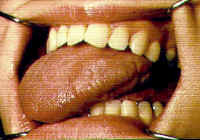| Contents
| The burning mouth syndrome (BMS) |  | |||
The burning mouth syndrome (BMS), glossodynia or oral dysesthesia is well described in literature as a clinical entity. The common complaint is a persistent burning sensation of the mobile and vulnerable mucosal of the tongue border and the lips. It is absent during meals and recurrent in nature. Numerous investigations stress the multiple variables in men and women. Perhaps BMS may be better understood as local symptom resulting from more factors which can influence the oral mucosa on the same way. In our study a supposed common factor is a minor degree of permeability in the mucosal lining due to superficial bacterial presence. It facilitates fluid transport which causes the burning sensation. The transport itself is generated by osmotic pressure. Inside the mucosa the osmotic pressure is about 290 mmol/kg while the osmotic pressure in saliva varies from 40 mmol/kg in resting saliva up to 100 mmol/kgh after stimulation. Little is know about the protective properties of the superficial mucous barrier outside the mucosa. Predisposing conditions for BMS are mucosal atrophy, mucosal disturbances as in vitamin B 12 deficiency, poor food intake on elder age and superficial inflammation by local microbial over growth or the adherence of yeasts. Xerostomia is a well documented common risk factor. Therapeutic strategy is outlined by investigation of causal factors. A simple solution in a number of cases is provided by tongue scraping or brushing in order to disrupt local bacterial over growth. The attached database is waiting further analysis.
|